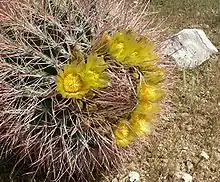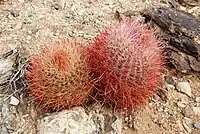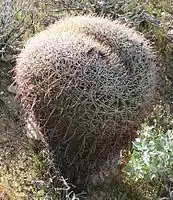| Ferocactus cylindraceus | |
|---|---|
 | |
| Scientific classification | |
| Kingdom: | Plantae |
| Clade: | Tracheophytes |
| Clade: | Angiosperms |
| Clade: | Eudicots |
| Order: | Caryophyllales |
| Family: | Cactaceae |
| Subfamily: | Cactoideae |
| Genus: | Ferocactus |
| Species: | F. cylindraceus |
| Binomial name | |
| Ferocactus cylindraceus (Engelm.) Orcutt | |
| Synonyms | |
|
Echinocactus viridescens var. cylindraceus Engelm. | |
Ferocactus cylindraceus is a species of barrel cactus which is known by several common names, including California barrel cactus, Desert barrel cactus, compass barrel cactus, and miner's compass. It was first described by George Engelmann in 1853.[2]
Distribution and habitat
This cactus is native to the eastern Mojave Desert and western Sonoran Desert Ecoregions in: Southern California, Nevada, Arizona, and Utah in the Southwestern United States; and Baja California, and Sonora state in Northwestern Mexico.[3][4]
It is found in gravelly, rocky, or sandy soils, in Creosote Bush Scrub and Joshua Tree Woodland habitats, from 60–1,500 metres (200–4,920 ft) in elevation.[5]
Description
Ferocactus cylindraceus is usually cylindrical or spherical, with some older specimens forming columns 2 metres (6.6 ft) in height. It is covered in long, plentiful spines, which are straight and red when new and become curved and gray as they age.[6]
The cactus bears flowers that are maroon outside, and bright yellow inside, with red or yellow centers on the side that faces the sun. The fleshy, hollow fruits are yellow.
Varieties
- Ferocactus cylindraceus cylindraceus— California barrel cactus.[7]
- Ferocactus cylindraceus lecontei (Engelm.) N.P.Taylor — Leconte's barrel cactus.[8][9]
- Ferocactus cylindraceus tortulispinus (H.E.Gates) N.P.Taylor

Conservation
Having a sculptural form and picturesque qualities, this already uncommon cactus is threatened by plant collectors.[5] It is also losing habitat to clearing for new wind farms and solar power plants in the Mojave Desert and Colorado Desert.
- Protected areas with notable populations include
References
- ↑ Burquez Montijo, A.; Felger, R.S. (2017) [amended version of 2013 assessment]. "Ferocactus cylindraceus". IUCN Red List of Threatened Species. 2017: e.T152556A121539513. doi:10.2305/IUCN.UK.2017-3.RLTS.T152556A121539513.en. Retrieved 22 May 2023.
- ↑ Anderson, Edward F. (2001). The cactus family. Timber Press. p. 327. ISBN 0-88192-498-9. Retrieved 28 August 2010.
- ↑ CalFlora Database: Ferocactus cylindraceus . accessed 4.1.2013
- ↑ CalFlora Database: Distribution Map (in California)
- 1 2 Jepson . accessed 4.1.2013
- ↑ Flora of North America . accessed 4.1.2013
- ↑ USDA, NRCS (n.d.). "Ferocactus cylindraceus (Engelm.) Orcutt var. cylindraceus". The PLANTS Database (plants.usda.gov). Greensboro, North Carolina: National Plant Data Team. Retrieved 7 June 2022.
- ↑ "UC/JEPS: Jepson Manual treatment for FEROCACTUS cylindraceus var. lecontei". ucjeps.berkeley.edu.
- ↑ USDA, NRCS (n.d.). "Ferocactus cylindraceus (Engelm.) Orcutt var. lecontei (Engelm.) H. Bravo". The PLANTS Database (plants.usda.gov). Greensboro, North Carolina: National Plant Data Team. Retrieved 7 June 2022.
Gallery
 Flower, in Palm Canyon, California.
Flower, in Palm Canyon, California. Red barrel cacti, Joshua Tree National Park.
Red barrel cacti, Joshua Tree National Park. Unusual shape, in Palm Canyon, California.
Unusual shape, in Palm Canyon, California.
